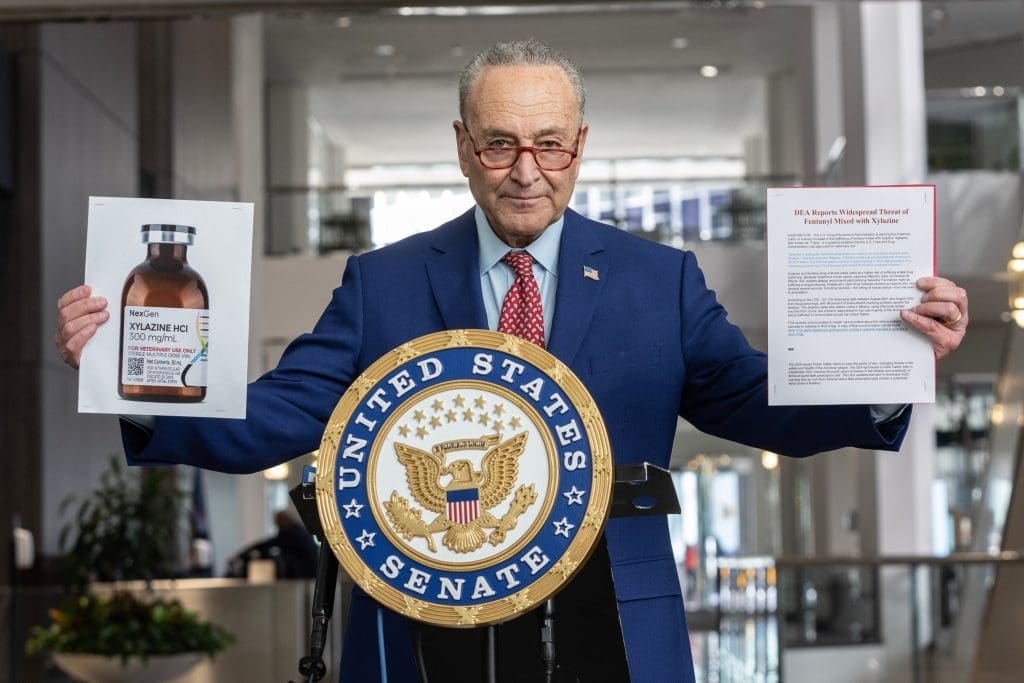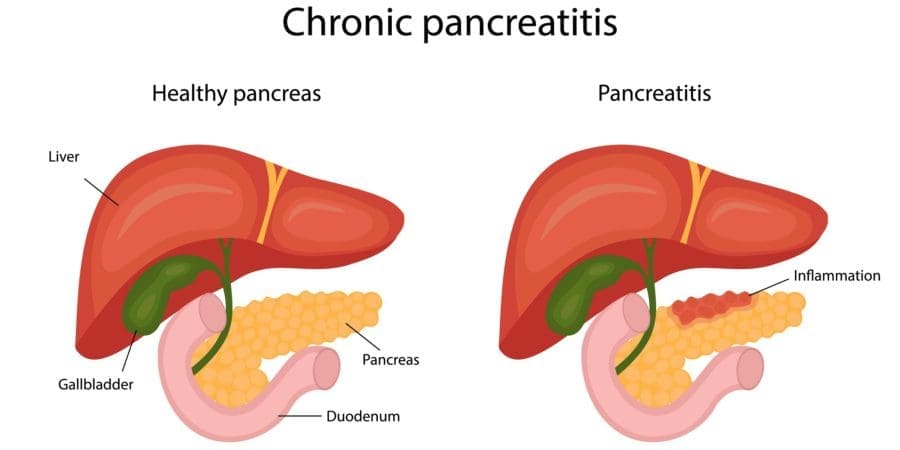The term “Zombie Drug” has gripped the public’s imagination, conjuring images of individuals in a trance-like, unresponsive state. This term broadly refers to drugs that drastically alter a person’s behavior and physical appearance, leading to zombie-like characteristics.
In recent years, Xylazine, a veterinary sedative, has become infamously linked to this term due to its severe effects on human users. This comprehensive guide delves into the world of Xylazine, exploring its uses, effects, and the reasons behind its alarming association with the term “Zombie Drug.”
If you are seeking information about addiction treatment for yourself or a loved one, and are in Western Ohio or the surrounding metro areas, give Ridgeview Behavioral Hospital a call today at 419-910-3383.
What is the Zombie Drug?

The Origin of the Term “Zombie Drug”
The term “Zombie Drug” has emerged as a powerful descriptor in the world of substance abuse and illicit drug use. This slang term encompasses a variety of substances, each known for inducing dramatic behavioral changes in users.
The evocative term gained widespread attention and traction due to the visually and psychologically disturbing effects these substances elicit. Individuals under the influence of such drugs often exhibit behaviors and physical appearances that starkly resemble zombies, as popularly depicted in horror films and literature.
This resemblance includes a noticeable disconnection from reality, a vacant or glazed-over expression, significantly impaired motor skills, and sometimes, a tendency towards aggressive or unpredictable behavior.
The public’s fascination and horror with the concept of zombies – reanimated, mindless beings with a primal, sometimes violent demeanor – have made the term “Zombie Drug” particularly resonant. It effectively captures the transformation seen in users, who may appear to lose their humanity and consciousness, becoming a shell of their former selves.
Xylazine as a Central Figure in the Zombie Drug Phenomenon
Xylazine, widely known in the veterinary field as a sedative for animals, particularly large mammals, has unfortunately found a notorious place in the narrative of the Zombie Drug phenomenon. This transition from a legitimate, controlled medical use to a substance of abuse in the human population is alarming. Often referred to as “Tranq” due to its tranquilizing properties, Xylazine becomes particularly dangerous when used by humans, and this danger is amplified when mixed with other substances like fentanyl.
The Profound Impact of Xylazine on Users
The classification of Xylazine as a “Zombie Drug” is attributed to its profound and severe impact on its users. Unlike drugs that stimulate or enhance sensory perception, Xylazine induces a state of heavy sedation and relaxation. This effect becomes critically hazardous when Xylazine is combined with fentanyl, an extremely potent opioid.
Xylazine and Fentanyl: A Lethal Combination
In recent years, the illicit drug market has seen a surge in the combination of Xylazine with fentanyl. Fentanyl is known for its powerful opioid effects, which can be up to 50 times stronger than heroin. When mixed with Xylazine, the sedative effects of both drugs are compounded, leading to an even greater risk of overdose and death. This combination significantly heightens the sedative and respiratory depressant effects, creating a potentially deadly cocktail.
The use of Xylazine with fentanyl exacerbates the already severe risk of respiratory depression, unconsciousness, and coma. Users may experience a profound disconnection from their surroundings, an increased risk of accidental harm, and a higher likelihood of fatal overdose. This combination has become a growing concern for health professionals and law enforcement agencies, as it complicates treatment for overdose and increases the danger to users.
Behavioral and Physical Consequences
When used illicitly by humans, especially in combination with fentanyl, Xylazine can lead to extreme levels of sedation, where users become incredibly lethargic, unresponsive, and disconnected from their surroundings. These effects are akin to the catatonia observed in fictional zombies and can leave users in a vulnerable state, unable to move or respond to stimuli. This state not only poses significant risks to the individual’s health but also often leads to hazardous situations, as users may be unable to protect themselves or might inadvertently place themselves in dangerous circumstances.
What is Xylazine?

Xylazine Definition and Use
Xylazine is a non-opioid sedative and analgesic primarily used in veterinary medicine, particularly for large animals like horses. Its primary function is to sedate and relax animals for medical procedures. However, its emergence in the illicit drug market has posed new challenges and risks.
Xylazine Specifics: A Deeper Dive
How Do You Pronounce Xylazine?
Xylazine is pronounced as “zy-luh-zeen,” with the emphasis on the first syllable.
What is Xylazine Used For?
Xylazine’s role in veterinary medicine is multifaceted. Primarily, it’s used as a sedative, providing a state of relaxation and drowsiness for animals undergoing various procedures. This sedative quality is particularly vital in managing stress and anxiety in animals during potentially distressing situations, such as surgeries or diagnostic procedures.
Moreover, Xylazine serves as an effective analgesic, meaning it helps in alleviating pain. This characteristic is essential in ensuring animal welfare, particularly in procedures that could cause discomfort or pain.
Another critical function of Xylazine in veterinary practices is as a muscle relaxant. This property is especially useful in procedures that require animals to remain still for extended periods, such as during certain surgical operations or intricate diagnostic tests.
Xylazine’s ability to offer prolonged sedation makes it particularly favored in veterinary settings. This prolonged effect ensures that animals remain calm and pain-free for the duration of longer procedures, thereby facilitating smoother and safer veterinary practices.
Is Xylazine a Controlled Substance?
As of my last update, Xylazine is not classified as a controlled substance in many regions. This lack of regulation has unfortunately contributed to its ease of availability and subsequent misuse in the human population. The drug’s potent effects, coupled with its relative ease of procurement, have made it an attractive option in the illicit drug market.
However, the growing abuse of Xylazine and its association with severe health risks have sparked discussions about potential regulatory changes. There’s an increasing acknowledgment among public health officials and law enforcement agencies of the need to control its distribution to prevent misuse.
Is Xylazine Ketamine?
Xylazine is often confused with Ketamine, another drug used in veterinary medicine. However, these two substances are distinct in both their chemical composition and their effects. While Ketamine is primarily an anesthetic, used to induce a loss of consciousness and sensation, Xylazine is a sedative and muscle relaxant. Unlike Ketamine, which creates a dissociative anesthesia, Xylazine’s primary function is to sedate and relax without necessarily inducing complete anesthesia.
Is Xylazine a Benzodiazepine?
Xylazine is not a benzodiazepine, a common misconception due to its sedative properties. Benzodiazepines, used in human medicine, are known for their calming effects, but they function differently from Xylazine. Xylazine belongs to the class of alpha-2 adrenergic agonists. This classification means it works by targeting alpha-2 adrenergic receptors in the body, which play a crucial role in regulating neurotransmitter release. This mechanism is distinct from how benzodiazepines interact with the brain’s GABA receptors.
What Does Xylazine Look Like?
In its legitimate veterinary form, Xylazine is typically a clear to slightly yellowish liquid. This liquid form allows for precise dosing and administration, usually via injection, for animals. However, when Xylazine finds its way into the illicit drug market, it can be altered into various forms. These include powders or pills, making it easier to distribute and consume illicitly. The alteration in form also raises the risk of impurities and unknown concentrations, adding to the dangers associated with its use.
How Long Does Xylazine Last?
The duration of Xylazine’s effects can vary, but generally, they last several hours. This duration is influenced by several factors, including the dosage administered and the individual animal’s metabolism. The sedative effects of Xylazine are particularly notable for their length, making the drug ideal for procedures that require animals to remain sedated for extended periods. In the context of illicit human use, this prolonged effect can be particularly dangerous, as it increases the risk of prolonged respiratory depression and other severe side effects.
In summary, Xylazine’s versatility as a sedative, analgesic, and muscle relaxant makes it a valuable drug in veterinary medicine. However, its misuse as a recreational drug poses significant health risks. Understanding its legitimate uses, chemical nature, and the implications of its misuse is crucial in addressing the challenges posed by this drug, both in veterinary medicine and public health. As discussions about its regulation continue, it’s essential to balance its legitimate medical utility against the risks associated with its abuse.
Xylazine’s Transition to the Streets
The Shift from Veterinary to Illicit Use
The transition of Xylazine from a veterinary sedative to a street drug is a concerning trend. Its potent sedative effects, coupled with the lack of control as a non-scheduled substance in many regions, have made it an attractive addition to the arsenal of illicit drug dealers.
The Effects of Xylazine on Humans
Sedation and Respiratory Depression
In humans, Xylazine causes deep sedation, significantly slowing down the body’s functions. This includes a marked decrease in respiratory rate, posing a significant risk of respiratory depression, especially when combined with other depressants like opioids.
The Physical Harm: Xylazine Wounds
One of the most visually disturbing effects of Xylazine abuse is the development of severe skin ulcers and infections, known colloquially as “Xylazine wounds” or “Tranq wounds.” These wounds can be challenging to treat and may lead to permanent scarring and disfigurement.
Xylazine Dependence and Withdrawal
Regular use of Xylazine can lead to physical dependence. Withdrawal symptoms can include anxiety, tremors, sweating, and agitation, making it difficult for users to discontinue the drug without medical assistance.
Overview of Flakka and the Zombie Drug

Flakka, a synthetic stimulant, stands out as a stark contrast to Xylazine in the realm of substances labeled as Zombie Drugs. This drug, chemically known as alpha-PVP, is part of a group of synthetic cathinones, often misleadingly labeled as “bath salts.”
Flakka’s rise to infamy is rooted in its ability to induce extreme behavioral changes, pushing users into states of intense agitation, hyperactivity, and at times, violent outbursts. These effects starkly mirror the depictions of zombies in popular culture, albeit with a frenzied twist, hence its inclusion under the “Zombie Drug” label.
The Chemical Composition of Flakka
Flakka’s active ingredient, alpha-PVP, is a synthetic version of cathinone, a stimulant found naturally in the khat plant. It’s designed to mimic the effects of other stimulants like MDMA or cocaine but often results in much more unpredictable and dangerous effects.
The synthesis of Flakka makes it particularly potent and capable of inducing extreme psychoactive effects.
Flakka as the Zombie Drug
Hyperactivity and Agitation
One of the most prominent effects of Flakka is a marked increase in energy and alertness, similar to other stimulants but often to a more extreme degree. This hyperactivity can escalate to severe agitation, leading users to exhibit highly unpredictable and sometimes violent behavior.
The unpredictable nature of Flakka’s effects makes it particularly dangerous, not just to the user but also to those around them.
Hallucinations and Paranoia
Flakka use can lead to intense hallucinations and paranoia. Users may experience vivid visual and auditory hallucinations, often leading to panic, fear, and aggressive reactions. The drug-induced paranoia can exacerbate these reactions, leading to dangerous situations where users feel threatened and react accordingly.
Violent and Erratic Behavior
The combination of hallucinations, paranoia, and extreme agitation can culminate in violent outbursts. There have been numerous reports of Flakka users engaging in aggressive, sometimes harm-inflicting behaviors, posing significant risks to public safety.
Physical Health Risks
- Hyperthermia: One of the most severe physical effects of Flakka is hyperthermia, a dangerously high body temperature. This condition can lead to muscle breakdown and kidney failure.
- Organ Failure: Prolonged use or high doses of Flakka can lead to potential organ failure. The strain the drug places on the cardiovascular system and other vital organs can result in long-term damage or acute emergencies.
- Neurological Damage: The intense stimulation of the nervous system can lead to seizures and potentially permanent neurological damage.
Potential for Overdose
The potency of Flakka, coupled with its unpredictable nature, raises the risk of overdose. Overdosing on Flakka can lead to severe complications, including heart attack, stroke, and even death.
In summary, Flakka’s inclusion as a “Zombie Drug” is due to its capacity to drastically alter behavior and physical health. The drug’s unpredictable and often dangerous effects underscore the need for increased awareness, education, and robust strategies to address its use and distribution.
Combating the rise of substances like Flakka is crucial in mitigating the risks they pose to individuals and society at large. As we confront the challenges presented by these potent substances, a concerted effort from public health officials, law enforcement, and communities is essential to safeguard public health and safety.
Understanding the Risks and Dangers
The Public Health Perspective
The rise of drugs like Xylazine and Flakka represents a critical public health issue. Their potent effects not only endanger the users but also pose risks to public safety and strain healthcare resources.
Strategies for Addressing the Crisis
Addressing the crisis involves a combination of law enforcement efforts to curb illegal distribution, public education to raise awareness of the dangers, and health interventions to support addiction treatment and harm reduction.
Conclusion: Addressing the Zombie Drug Phenomenon
The rise of the Zombie Drug, especially Xylazine, underscores the ongoing battle against substance abuse and its impact on society. These substances not only endanger the health and well-being of users but also pose broader societal risks.
Addressing this issue requires a comprehensive approach, combining education, healthcare, law enforcement, and community engagement. Understanding the nature and effects of drugs like Xylazine is essential in formulating effective strategies to combat this crisis.
Through collective efforts, there’s hope for mitigating the dangers posed by the Zombie Drug and improving public health and safety.
If you are seeking information about addiction treatment for yourself or a loved one, and are in Western Ohio or the surrounding metro areas, give Ridgeview Behavioral Hospital a call today at 419-910-3383.





















